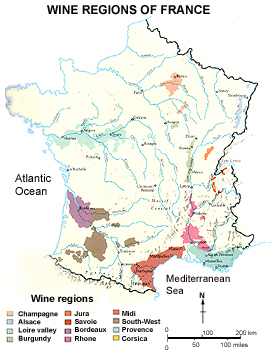| |



One of the reasons for the dominance of French wines is the extraordinary range the country makes. This is thanks to its wide span of climates, which allows light white wines to be made in the Loire, and powerful red ones in the Midi. France has exploited this to assemble a list of wines, or wine regions, which dominate the world. Bordeaux, Bur-gundy and Champagne each make styles of wine which are unsurpassed, though widely imitated. The great names ring around the world: Mouton--Rothschild, Chambertin, Krug. The second rank -the Loire, Rhone, Alsace - makes wines if anything more inimitable. Then there is the broad spread of appellations and districts making their own wines according to deep-rooted traditions: Cahors and Madiran, Provence, the Jura. All these districts and more make at least some wines of serious quality in world terms. Beyond this again is the whole range of French wines, which may be almost unknown outside their home country, or even province, but which offer fascinating and individual flavours. Think of Limoux, with its sparking wines; of the Aveyron hills with their unique Marcillac red; of Bellet near Nice with its unexpectedly good whit wines. Then there are the mass-production wine areas where islands of real quality can be found amid the cheap blending wines: the crus of
Languedoc, the Minervois and Corbieres hills.
This list of French wines could have been written at any time in the last two centuries. Indeed,
It would have been longer: the phylloxera plague and changing patterns of commerce drove many a vigneron from the land, and left many a terraced hill side deserted. But in the 1980s a new wave of innovation swept the French wine regions, especially those of the south - the Midi - and this is prompting the growth of new wines. To the list of French classics, great and minor, can be added classics in the making. In the hills of the Midi a return to old vineyards and vines, allied to the latest in techniques, is yielding wines which stun tasters in New York Paris and London with their quality. The same is true in Provence, in the wide lands of the southern Rhone, and in the vineyards of the south-west.
Added to this revitalization has been the updating of the more recent, mass-producing, vineyards of the plains. Australian and American techniques and attitudes are shaking up the sad, featureless wine lands here, with open-minded experts finding that the conditions are suitable for good wine from classic grapes. France is now making wines labelled "Chardonnay" and "Cabernet Sauvignon" (in the New World fashion of wines named simply from cepage), from grapes grown in the Midi, processed according to the latest New World thinking and marketed in an outgoing, designer-bottle. New World way - with no concessions to classic French wine notions about terroir and tradition. This had more success in export markets than at home as the French public is, taking time to adapt to the idea that the Midi can make interesting wines, but the heartening news for French wine is that these bottles meet and beat New World varietals" on their own terms in price, presentation and above all flavour.
France is gaining a new wine dimension to add to its classics. And it is important to note that the classic regions, too, have seen what is hap-pening in the wider world and reacted to it. New generations of educated, outward-looking wine-makers and proprietors have taken over in Burgundy, the Rhone and Alsace. In Bordeaux, with its tradi-tion of wider horizons, there was less of a revolution, but its homegrown expertise has been spurred on by competition to raise the overall stan-dard of its wine by a discernible step. Even Champagne, which according to its own messengers had achieved perfection a century or so back, has seen changes in viticulture and mat-uration which have enhanced the quality of the wine.
|
|
|
|





